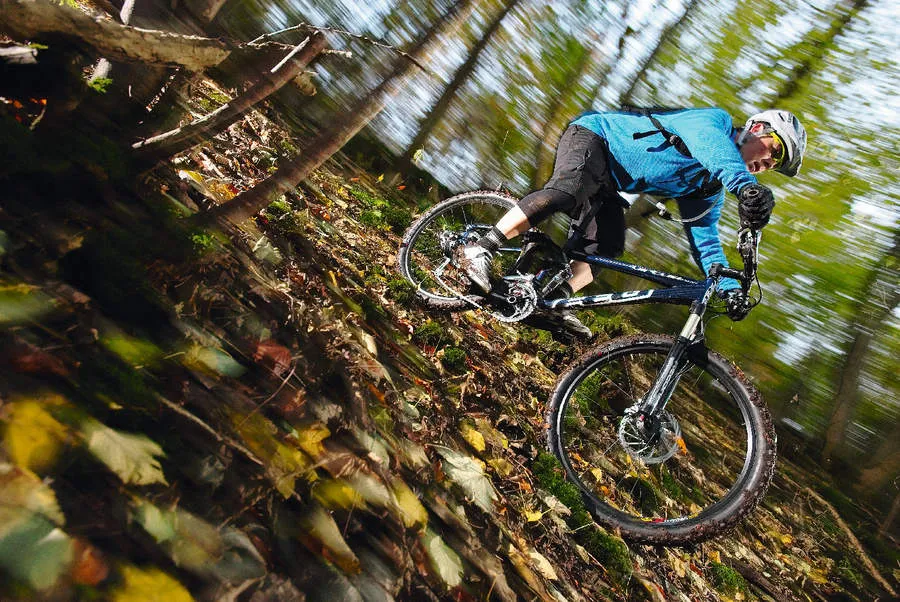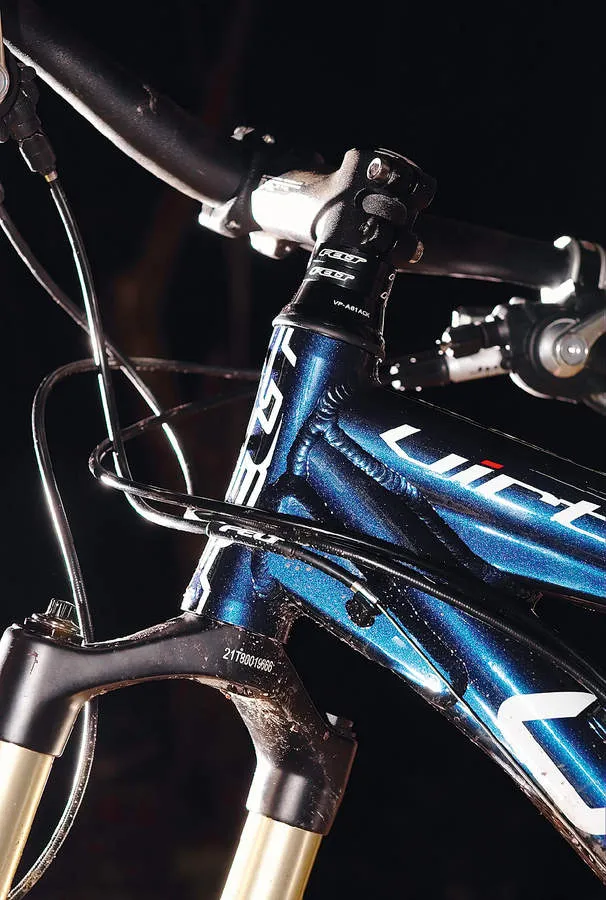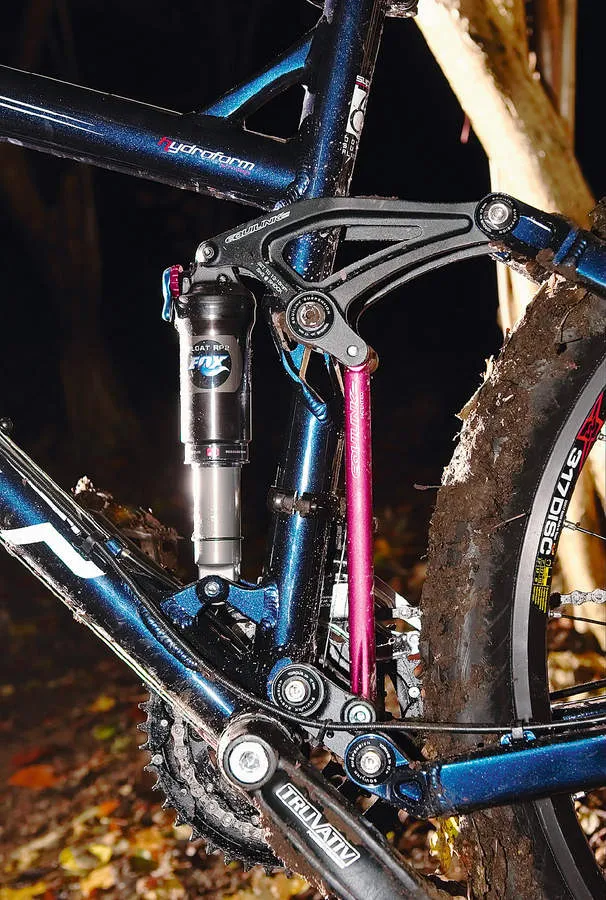If you’re a rider looking for a dependable, tough and capable trail bike with a penchant for upwards action, sat on the Felt Virtue 2 is a good place be. We expected, and wanted, the Virtue 2 to weigh a bit less than it does, but in truth it doesn’t hold the bike up much – just get it moving and up to speed and it’ll bound along all day.
It's the same with the geometry, which we’d like to be slacker for added ability in the rough, although we still had fun. Oddly, the two features combine and cancel each other as the bike happens to climb with better control and manners than most other five-inch-travel bikes we’ve ridden.
Ride & handling: Good on the climbs but slacker angles would aid descending
When Felt launched themselves back into the mountain biking mainstream in 2006, they did so with their svelte, slimline Virtue bikes with their Equilink rear suspension technology. The 130mm Virtue was an immediate hit with hard riding, terrain challenging cross-country riders who appreciated the flexibility another 30mm of travel gave to their line choices on technical trails, combined with a near 25lb rolling weight (on the top Virtue 1 model).
Slowly, the original Virtue has morphed into the 2009 version we see here. Over the past three years the Virtue bikes have gained a little weight, which for a performance-oriented trail bike isn’t usually a recipe for success.
We also feel that all three bikes in Felt's Virtue range need to lose half a degree in both their seat and head angles. On the medium-sized Virtue we tested, the head angle is 70 degrees and feels like it ought to be a 69.5 to allow you to sit behind the 130mm RockShox Recon fork and let it work to best effect.
Likewise, the seat angle is 73.5 degrees and could do with being 73 degrees. As it is, you feel positioned too far over the bottom bracket for such a leggy and potentially hard-hitting trail bike. But the tight frame angles make climbing steep pitches a piece of cake, giving total command over the steering.
However, while good climbing habits are to be commended, most riders will take a hit in that department to get a slacker, more trail-hungry geometry that encourages you to open the throttle at every opportunity. As it is, the Felt feels upright – perfectly good to ride, just not quite the rollercoaster it could and, in our opinion, should be.

Frame: No longer a lightweight racing whippet, but a tough, dependable trail bike
Our 2009 Felt Virtue 2 weighs 28.2lb, which is on-par for its class as a dependable trail bike but means the Virtue has had its cross-country race wings clipped.
In its defence, the 7005 series alloy framed Virtue 2 does give off the air of a bike ready to get stuck into technical situations and ignore occasional unplanned off-trail excursion without too much worry.
The head/down tube junction is gusseted and the extended seatmast braced for strength and durability, while the tubes appear sufficiently stout to remain ding-free for some time.
The back end of the frame is where the real interest is. At first glance you’d think this was a standard faux bar rear end with a seatstay-mounted pivot, but further inspection reveals a small red alloy tie-bar that connects the chainstays (behind the seat tube-mounted swing arm pivot) and the underside of the rocker linkage.
Felt claim this design will effectively eliminate pedal-induced suspension activation, without the need for using ProPedal or similar damping circuits found on new air-sprung rear shock units, and for the most part it does this perfectly. We ride without ProPedal most of the time, only using it with lower shock pressures.
Overall the Virtue 2 has a solidly built frame with well behaved suspension across most types of terrain. But as mentioned earlier, the head and seat angles are about a half a degree too steep, placing the front wheel under the headtube rather than ahead of if, making the ride slightly nervy.

Equipment: Solid spec for all-day riding courtesy of RockShox, SRAM and Mavic
The Virtue 2 theme of ‘all day riding and no messing’ is a sentiment that is matched by its parts spec. The 130mm travel RockShox Recon 327 air-sprung fork sets the Virtue 2’s all-mountain agenda.
Componentry is courtesy of SRAM (excluding the Shimano Deore front mech) with a solid, if drab, Truvativ Firex chainset, SRAM X7 shifters and X9 rear mech providing reliable shifting whatever the weather.
The finishing kit is fine, although we hoped we’d seen the last of seatposts with grooved head adjustment. The long nosed own-brand Fizik-look-alike saddle was comfortable and offered lots of positioning options. The Felt 100mm stem was a centimetre too long, though the low-rise bar was a full 680mm wide and felt perfect.
Wheels can make or break the ride on any bike and especially on trail bikes where excess weight is obvious. The Mavic XM-317 rims on Shimano hubs shod in Felt’s own 2in tubeless tyres offered dependability and durability at the slight expense of acceleration and climbing prowess.
Essentially the parts pick is good, with room for some careful weight shaving after the initial glory rides are done.

Tester’s thoughts
“I was disappointed with the Virtue 2 because Felt has blunted what was the Virtue’s strongest suit – its blend of 130mm travel with low mass. Now that travel invites you to tackle technical terrain at speeds the steeper geometry finds hard to cope with.” Justin Loretz

Designer's response
We asked Andy Holmes, the Brit in the hot seat at Felt, about the Virtue
Why are the ’09 Virtues getting heavier?
The ’09 Virtue chassis with its carbon rear has gained 110g over the first generation. But chassis stiffness has increased remarkably, as has small bump compliance and power transmission efficiency.
Original Virtues had real cross-country performance. Have you tried to change that?
Virtues are still a raceable platform. In fact, we have bikes used as race rigs built up well under 25lb with wide riser bars, 2.3in tires and no overly exotic components. Many of our product development and race team riders regularly use the Virtue to compete in cross-country, endurance and 24-hour events over our lighter race hardtails.
What does the future hold for the Virtue?
For 2010 you will see the Virtue moving back toward that lightweight model we originally started with. You will note that the current Virtue 1 is a conservative XT spec, and even with standard parts we’re able to hit a respectable 26lb. While there are many benefits to carbon fibre’s application in a mountain bike, we don’t want to jump into building a carbon suspension frame without first maximising the capabilities of aluminium.



